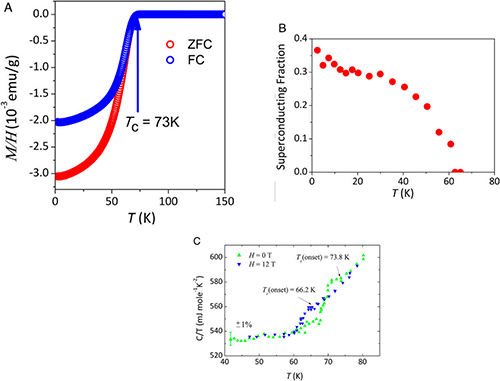Jun 28 2019
One of the most inexplicable phenomena in nature is superconductivity because the materials can conduct electrical current with no resistance.
 The superconducting transition of the sample showing Tc at 73 K (A) The Meissner effects; (B) Superconducting volume fraction in terms of superfluid density estimated from µSR; (C) Specific heat measurement. (Image credit: JIN Changqing)
The superconducting transition of the sample showing Tc at 73 K (A) The Meissner effects; (B) Superconducting volume fraction in terms of superfluid density estimated from µSR; (C) Specific heat measurement. (Image credit: JIN Changqing)
To date, the cuprates possess the highest superconducting temperature at ambient pressure; however, understanding their superconducting mechanism continues to be one of the greatest problems of physical sciences and mentioned as one of the 125 big quests reported by Science.
The latest finding by Professor JIN Changqing’s group at Institute of Physics of the Chinese Academy of Sciences (IOPCAS) on a new high Tc superconductor Ba2CuO4-δ exhibits two exceptional features: heavily over-doped hole carriers and a remarkably compressed local octahedron.
These two features are extremely different from the favorable criteria for all earlier recognized cuprate superconductors.
The compressed local octahedron causes a reversed orbital order with 3z2 lifted above 3dx2-y2 resulting in a strong multiband scenario, whereas the over-doped state infringes the earlier mot holding for superconducting phase.
Remarkably, the new material exhibits superconducting transition temperature with Tc beyond 73 K, which is 30 K more when compared to that of the isostructural classical “conventional” superconductor based on La2CuO4.
Therefore, the detection of high Tc superconductivity in Ba2CuO4-δ raises doubts about the generally established scenario of superconductivity in the cuprates.
This finding offers a completely new path to look for higher Tc superconductors.
This work entitled “Superconductivity in a unique type of copper oxide” was reported on PNAS.
The research was supported by the National Science Foundation and the Ministry of Science and Technology of China.